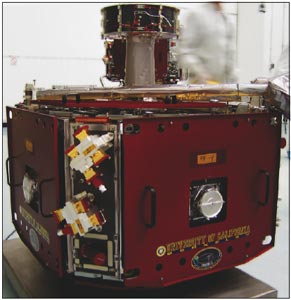Particle detectors developed for high-energy and nuclear physics often find uses in many other fields. Now silicon detectors with thin entrance contacts have been launched into space aboard the five spacecraft in NASA’s THEMIS (Time History of Events and Macroscale Interactions during Substorms) mission. Fabricated at the Lawrence Berkeley National Laboratory (LBNL), the detectors comprise the heart of solid-state telescopes (SSTs). They will study electrons and ions with energies between 25 keV and 6 MeV.

Image credit: NASA.
THEMIS will study the Aurora Borealis. Typically, the aurora is seen as a steady greenish-white band of light. Occasionally the band will move south and become brighter. Then, the auroral band may break up into many bands, some of which will move back towards the north, dancing rapidly and turning red, purple and white. This display is caused by an auroral substorm. The THEMIS mission will study the origin of these substorms. The five separate satellites were launched into highly elliptical orbits using a single Delta 2 rocket. The craft are strategically positioned to determine the location and sequence of the events that lead to these colourful displays.
Two SSTs are on board each of the spacecraft. Their purpose is to measure the distribution of energies of the electrons and ions arriving at each spacecraft from different parts of the magnetosphere. LBNL’s Microsystems Laboratory fabricated the silicon-diode detectors. They are large-area detectors that have very thin entrance contacts, only a few tens of nanometres thick. This allows them to detect electrons and ions with energies much lower than those that can be detected with standard silicon detectors. The detectors themselves can detect 2 keV electrons and 5 keV protons. However, the low energy threshold of the SSTs is determined not by the detectors, but by the noise performance of the electronics, which is limited by the available power.

Image credit: LBNL.
Because the detector contacts are so thin, making enough large detectors posed a significant challenge: the project required 80 flight detectors. However, the Microsystems Laboratory provided advanced equipment and processes in an ultra-clean environment that enabled the fabrication of these detectors with high yield.
The SSTs have been commissioned and are now returning scientific data on the magnetosphere during the current “Coast Phase”. In December, when the satellites will be in their required orbits, the primary task of studying the auroral substorms will begin.







